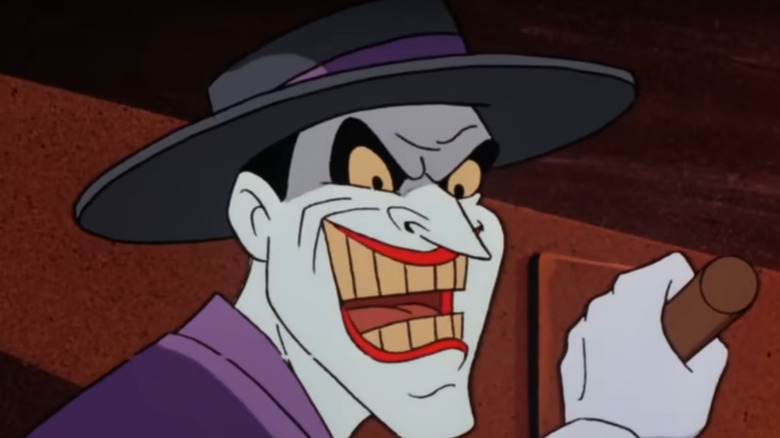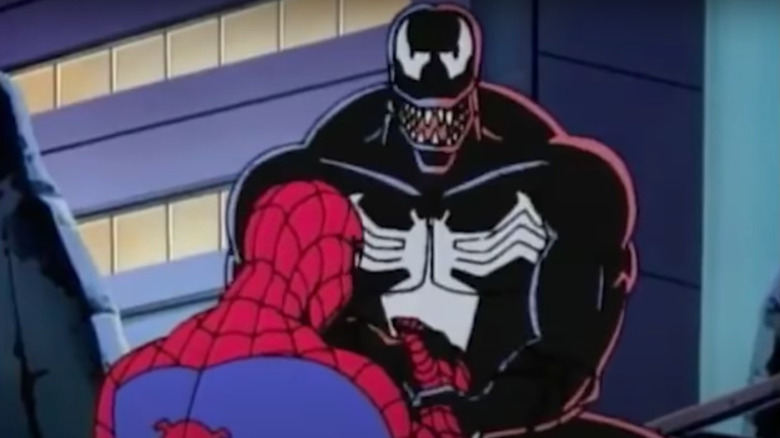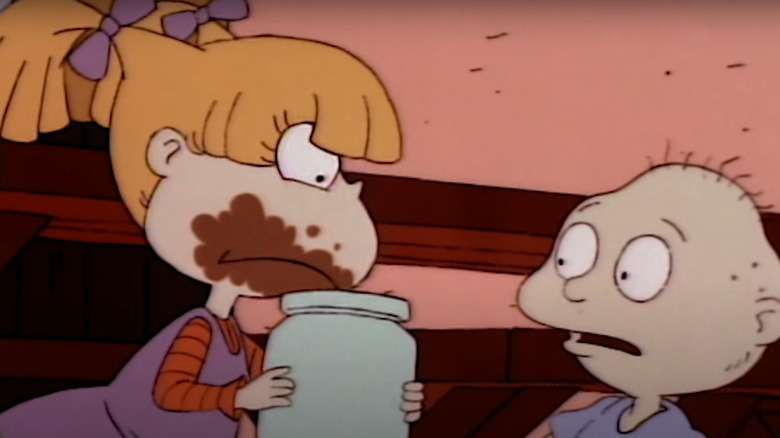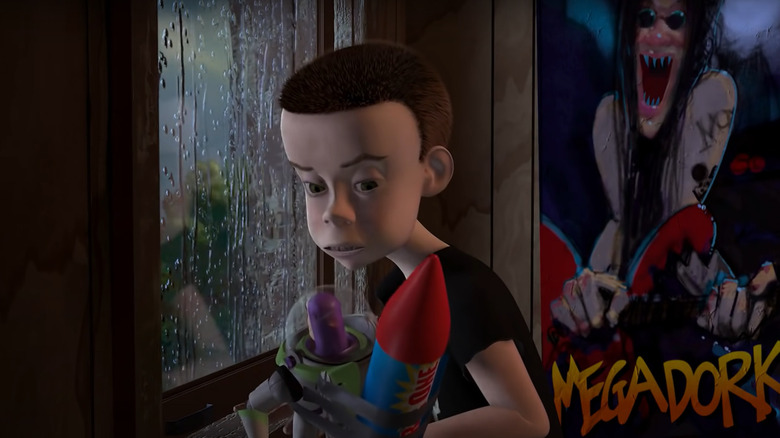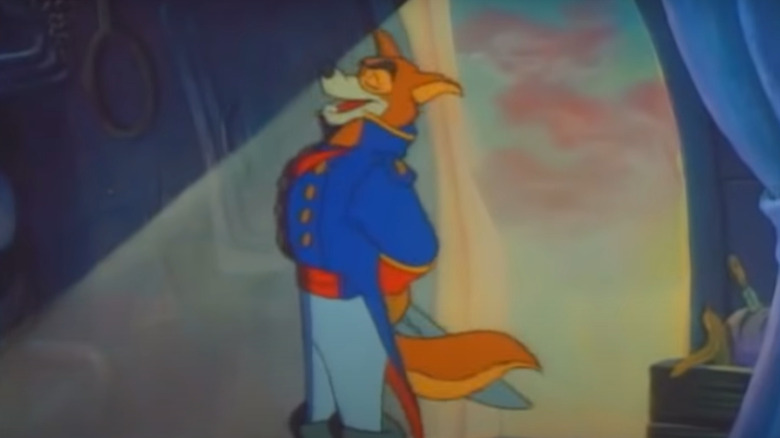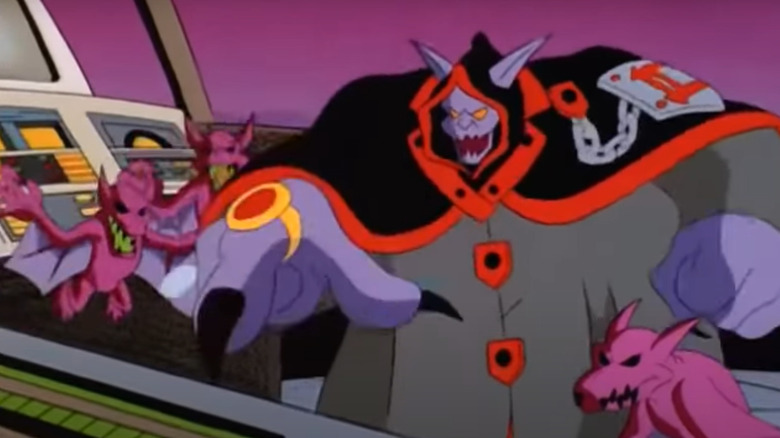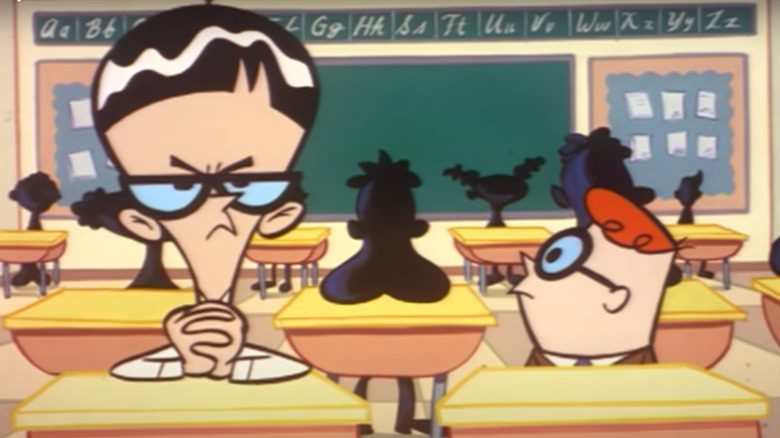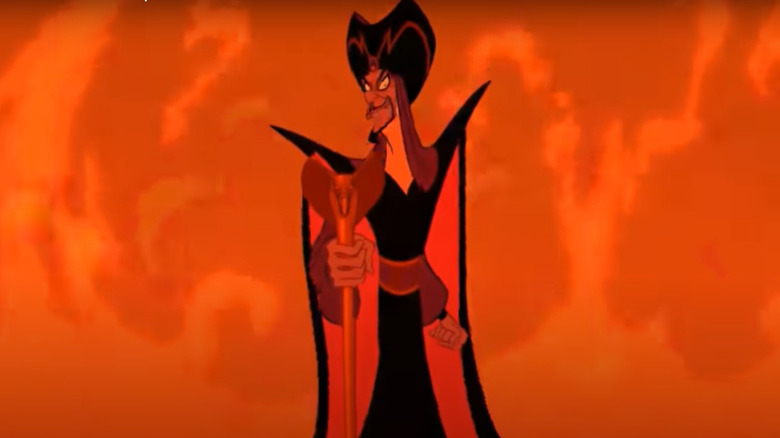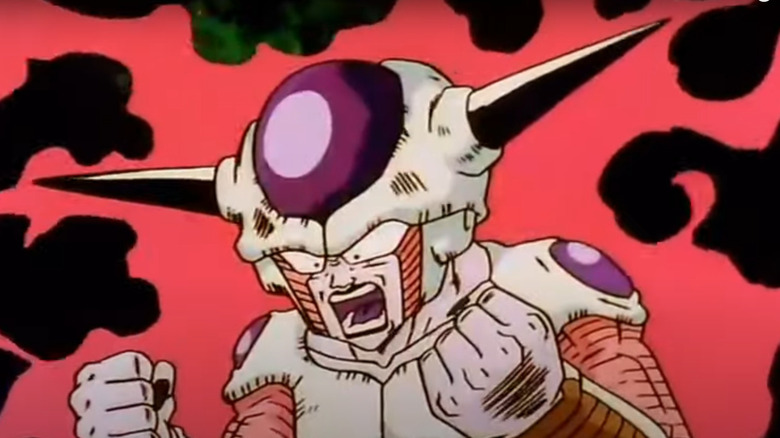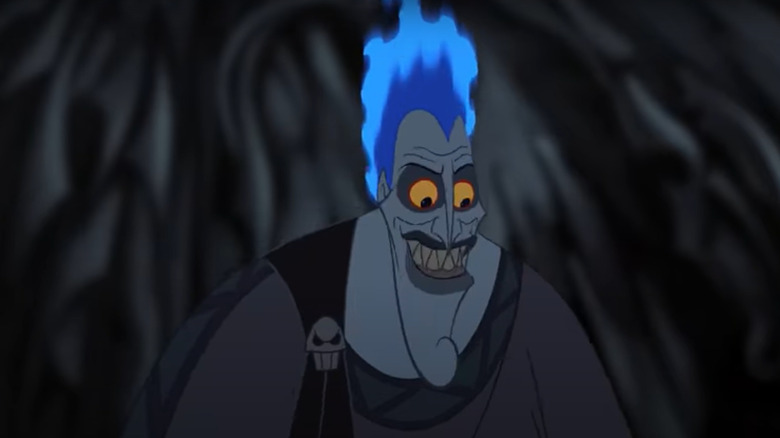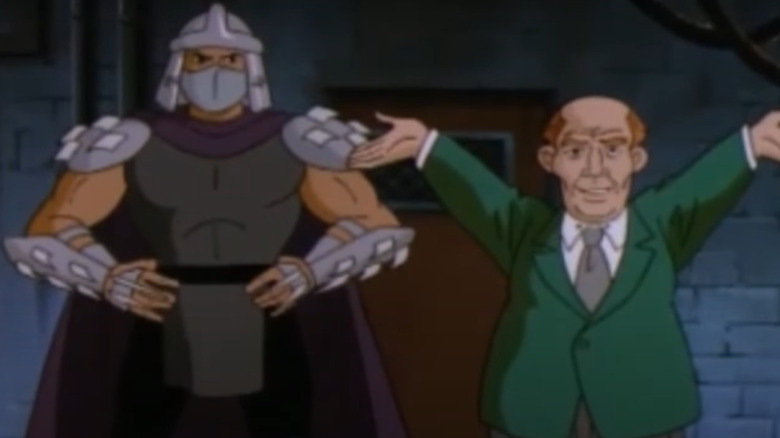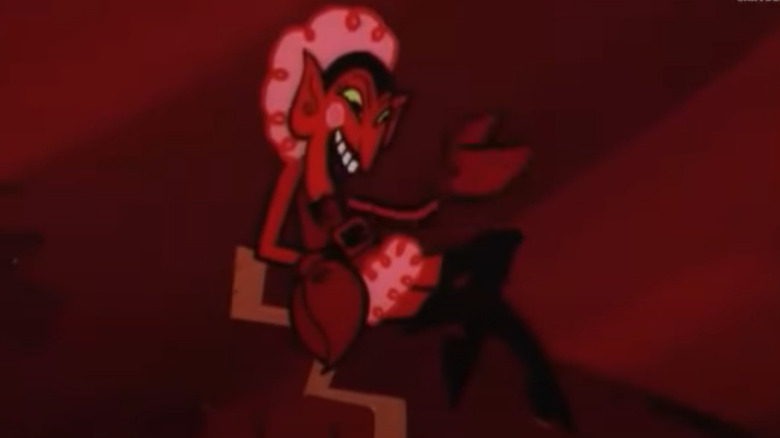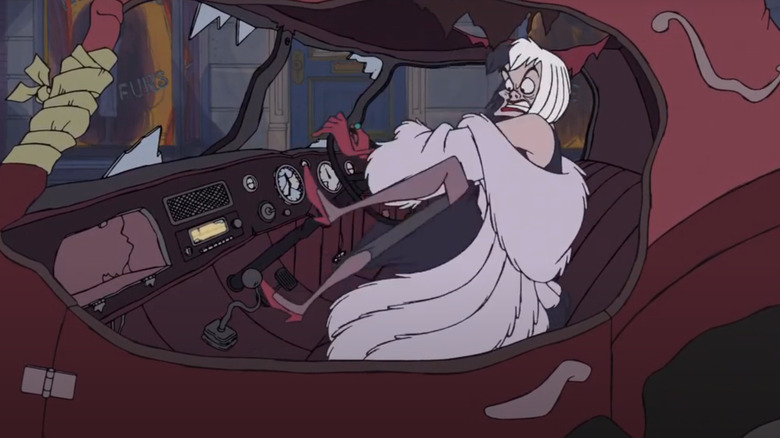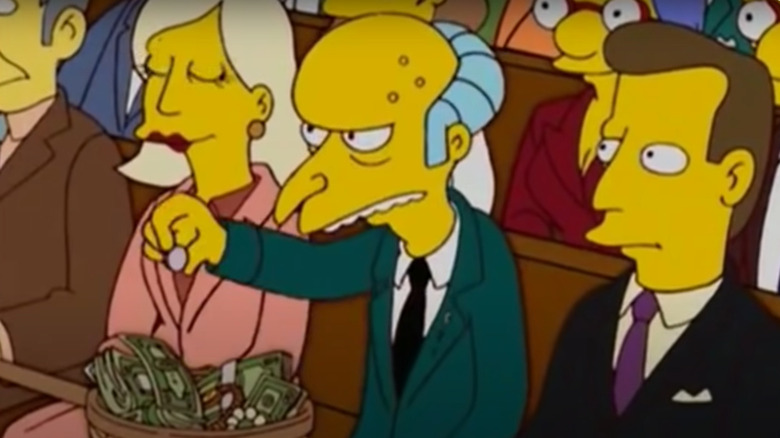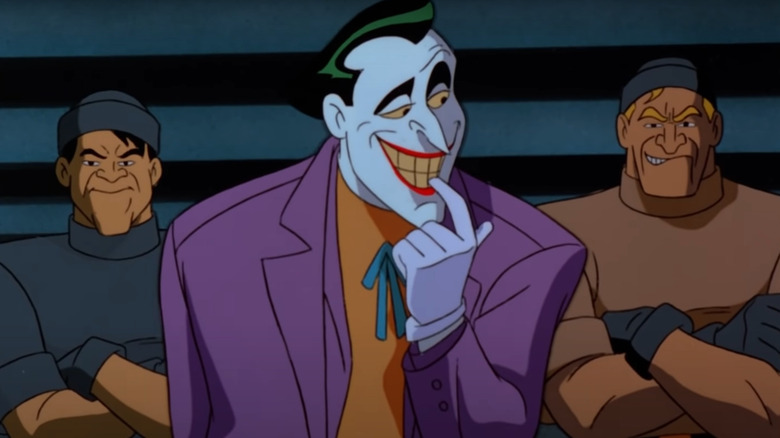The Best Animated Villains Of The '90s
The '90s were an exciting time for the animation industry. On the one hand, a strange little show called "The Simpsons" was redefining the way general audiences looked at cartoons by featuring adult topics and grounded satire. On the other hand, the Cartoon Network channel was launched, promising the never-before-seen feat of running cartoon shows 24/7, requiring a host of new animators and storytellers to fill the content requirement, and upping the ante for other animation studios.
Finally, anime cartoons from Japan were starting to gain popularity in the west, bringing with them a whole new style of animation unlike anything seen before on American televisions. All these factors combined to make the '90s a sort of renaissance period for a new wave of cartoons, ones that were a far cry from the less complex Looney Tunes and Hanna-Barbera offerings of old.
One of the strongest indicators of this shift in the industry was the creation of a new type of cartoon villain. One who was not corny and over-the-top, but cool and legitimately menacing. The '90s have gifted us with some of the most iconic animated villains of all time. Here are 14 of the best (or rather, the worst) bad guys from that era.
Venom (Spider-Man: the Animated Series)
"Spider-Man: The Animated Series" (1994-1998) was not the first time that the immensely popular webbed wall-crawler had appeared in animated form. But this version of cartoon Spider-Man is possibly the most iconic of them all. The series featured a noticeably darker look than previous incarnations of cartoon Spider-Man, and was famous for adapting some of the most popular comic storylines.
One such storyline was "The Venom Saga," which introduced viewers to Spidey's most iconic villain, the symbiote Venom. What made this villain better than others on the show was that "The Venom Saga" was not just about Venom fighting Spider-Man, but Spider-Man fighting his own dark impulses after the symbiote attaches itself to him and makes Spidey lose his inhibitions.
For the first time, fans saw nice, clean-cut Peter Parker acting like a bully and treating his enemies with a brutal abandon akin to the Punisher. Then, just when it seemed things could not get any worse, the symbiote found Eddie Brock and assumed the form of the hulking, monstrous supervillain Venom. With his enormous strength, creepily long tongue, and determination to make Spider-Man suffer on a personal level, Venom set a high bar for all comic book villains.
Angelica Pickles (Rugrats)
Launched in 1991, "Rugrats" was one of the original animated shows that put Nickelodeon on the map as a formidable competitor to Disney and Cartoon Network. While the concept of "talking babies" was something that other movies and shows had explored before, "Rugrats" took a more intimate approach to the concept of a separate social order for babies. A particularly formidable member of that order was Angelica Pickles.
Angelica was slightly older than the main group of toddler characters. As such, she had a foot in both worlds, being able to understand the babies talking to each other, as well as being able to communicate more directly with adults. Unfortunately, just because she understands what the babies are talking about does not make her like them. Angelica hates it when anyone other than her gets attention, and frequently mocks the children and likes to make them feel bad.
Over time, Angelica went from being a classic bully to having a begrudging respect and affection for the babies. But she could still be a terror when the mood struck her. Like convincing Tommy, Phil, and Lil that Chuckie is an alien. Or turning the twins against one another. Or faking a ransom to get free goodies.
Sid (Toy Story)
1995's "Toy Story" is one of the most influential movies ever made. Not only did it finally bring CGI animation into the mainstream, but it also gave Pixar a massive hit with its first feature-length film, as well as paving the way for cartoon films that deal with mature themes through childhood archetypes. One of those archetypes that "Toy Story" presented to the world with was Sid Phillips, the neighborhood bully.
Although Sid does not possess superpowers or great wealth like many other entries on this list, he makes up for it through his cruelty towards those under his limited sphere of influence. Sid is a kid who enjoys mistreating smaller creatures like his little sister, as well as any toys that cross his path. Seeing Sid's collection of toys is like visiting a museum of horror, and it is hard to believe that a single kid is capable of such wanton destruction.
Despite the threat he posed in the movie, Woody and his allies were able to teach Sid a lesson by the end of the story. That lesson seems to have stuck. While the Sid who showed up in the first movie was clearly headed down a bad path, we meet him again as an adult later in the series in "Toy Story 3," where he is shown to have gotten a respectable job as a garbageman and appears to be much more well-adjusted.
Don Karnage (TailSpin)
Before Jack Sparrow swaggered into the role of "coolest pirate ever," that title belonged to air pirate Don Karnage, the main antagonist of "TailSpin" (1990). If you were to ask what is an "Air Pirate?" Karnage will be happy to tell you himself, preferably with a musical number thrown in.
While most '90s villains were known for their forbidding demeanor, Karnage was loud and debonair. Even though he was a ruthless pirate, he was also a person of honor. He saved the life of his arch-enemy Baloo to pay the latter's debt to him, and once spared Baloo's life because the circumstances of their battle were unfair.
Karnage is remembered as an awesome villain not by the breadth of his evil deeds, but how much fun he always was in his scenes, especially when paired with his gang of space pirates. Although Shere Khan was the most dangerous villain in "TailSpin," Karnage took the cake in terms of entertainment value and his insistence on sticking to the pirate's code of honor.
Dark Kat (SWAT Kats: The Radical Squadron)
The '90s saw an influx of shows about anthropomorphic animals kicking butt and being "cool," thanks to the success of the "Teenage Mutant Ninja Turtles" franchise. "SWAT Kats: The Radical Squadron" (1993-1994) was one of the best shows to come out of that race, and it had a worthy main villain in the form of Dark Kat.
Tall, dark, and immensely forbidding, Dark Kat was a dangerously intelligent crime lord who dabbled in the dark sciences. This gave him mastery over an army of gargoyle-like creatures called Creeplings. There are elements of Skeletor from "He-Man" and Doctor Doom from the "Fantastic Four" in Dark Kat's design, and the result is something distinctly chilling despite the fact that he is supposed to be an anthropomorphic cat.
As far as plans go, Dark Kat has the standard motivation of "tear down the city and remake it in his own image" that so many megalomaniac villains are into. What made Dark Kat so formidable was that he was a brilliant tactician who could formulate the most elaborate plans to bring about his ends, and was also more than capable of holding his own in one-on-one combat against the heroes.
Mandark (Dexter's Laboratory)
"Dexter's Laboratory" (1996-2003) was possibly the most influential children's cartoon of the '90s, and every character on the show has since become a cult favorite, from the titular boy genius to his sister DeeDee, the Justice Friends, and Mandark, Dexter's arch-enemy.
There isn't a lot you can say in praise of Mandark that he hasn't already said himself. Mandark delights in proving to Dexter that he is only the second most intelligent boy on the planet. This epic rivalry led to some dicey moments for Dexter and DeeDee, who Mandark is smitten with. Even when Dexter and Mandark occasionally manage to put their differences aside to battle a bigger threat, the peace never lasts long and the two always end up at each other's throats.
In the first couple of seasons, Mandark was merely depicted as Dexter's rival for the title of "Smartest Kid in the World." As the series continued, Mandark's villain cred was boosted as he proclaimed himself the "Monarch of Darkness" and his plans started taking on a much darker aspect. What else can you expect from a kid who, at such a young age, already has one of the best evil laughs in all of fiction?
Jafar (Aladdin)
Despite their reputation for kid-oriented fare, Disney could pull out some genuinely scary villains for their animated movies when the occasion demanded it. Case in point, Jafar, the main antagonist of 1992's "Aladdin" who also later showed up in the sequel film, as well as the television series based on the movies.
Jafar started out as the Royal Vizier of the fictional city of Agrabah, where his secret magic powers and scheming pet parrot Lago allowed Jafar to manipulate events in such a manner as to uncover the mythical genie's lamp. The scary thing about Jafar was that he was smart enough to actually complete his evil plans and win the day. It was only when he got greedy for more power that Aladdin was able to trick Jafar into getting trapped inside the lamp as its new genie.
When Jafar showed up in the sequel, "The Return of Jafar," he was as wily and dangerous as ever, even while still being confined to the lamp. It was only a last-minute betrayal by Lago that allowed Aladdin and his allies to gain the upper hand over Jafar. Even that defeat did not prove to be a permanent solution, and Jafar showed up once again in the "Hercules" and "Aladdin" crossover episode "Hercules and the Arabian Night."
Frieza (Dragon Ball Z)
In the west, cartoon villains, no matter how evil, usually have some sort of morality that gives them a chance at redemption or at least some sympathetic motivations that the audience can get behind. Anime villains, on the other hand, have no problem being truly, horrifically evil. Frieza from "Dragon Ball Z" is one of the foremost examples of the latter kind of irredeemable villain.
Although the "Dragon Ball Z" anime was initially aired in Japan in 1989, the series aired in the U.S. in first-run syndication from September 13, 1996 to May 23, 1998. The show introduced western audiences to the world of action-packed anime. It's hero Goku faced off against a number of formidable enemies, but none were more powerful or diabolical than Lord Frieza.
What makes the character so dangerous is not only that he belongs to a long line of galactic conquerors with vast armies and resources, but in physical strength Frieza is also one of the most powerful beings in the multiverse, capable of destroying entire planets with a single shot. To cap it all off, Frieza actually enjoys torturing his enemies and destroying entire civilizations on a whim. Truly, a nasty customer.
Hades (Hercules)
Playing a literal god can be a challenging task for an actor, and most try to infuse such roles with as much gravitas as possible. James Woods took a different approach when he voiced Hades, the Greek God of the Underworld in 1997's "Hercules." Instead of making Hades a towering, menacing figure, Woods infused the character with the charm of a smooth-talking car salesman with a sharp sense of humor.
The result was one of the most entertaining villains ever seen in a Disney film. Woods' Hades is a liar and a manipulator, but he goes about his rotten business with such good humor that you can't help but be entertained. Despite his genial nature, as evidence by his method of introducing himself with lines like: "Name's Hades, Lord of the Dead. Hi, how ya doin'?", there is also an inherent menace to him, due to the fact that he is, you know, the literal embodiment of death.
Woods made a return as Hades in 1999's "Hercules: Zero to Hero," an animated series prequel that focused on a teenage Hercules. Once again, Woods' take on Hades was one of the highlights of the show, with the character scheming time and again to complete his quest to become the new ruler of Mount Olympus in place of Zeus.
The Shredder (Teenage Mutant Ninja Turtles)
With the release of their television series "Teenage Mutant Ninja Turtles" (1987- 1996), the titular turtles were at the height of their popularity in the '90s. Leonardo, Michelangelo, Donatello, and Raphael were every young boy's fantasy of being pizza-eating, nunchuk wielding, skateboarding ninja superheroes. They also had one of the coolest arch-enemies of all time in the form of the Shredder.
Shredder is who you get when you cross Darth Vader with Wolverine. His appearance alone is enough to make you want to cross quickly to the other side of the road. Shredder had the skills to back up his fearsome appearance, as well, even if his underlings in the Foot Clan were never much of a threat. You know stuff was getting serious if you saw Shredder himself wade into battle.
Over the years, Shredder has been provided with various motivations and backstories — from being a remorseless villain who wants to rule the world, to wanting to avenge the death of his brother, to that time he was a red alien Utrom named Ch'rell. But no matter the backstory, the Shredder remains the most formidable enemy that the Ninja Turtles have ever faced.
HIM (The Powerpuff Girls)
The three main characters of "The Powerpuff Girls" (1998-2005) are as adorable a bunch of superheroes as you could ever hope to see. But as cutesy and whimsical as the show got, it also featured characters and situations with a much more adult bend. No better example of this could be found than in the villainous "His Infernal Majesty," usually shortened to simply HIM.
Trying to describe HIM can be a difficult task, because nobody's really sure exactly what kind of a creature he (it?) is. HIM is shown to possess vast demonic energies, and his androgynous appearance is similar to many classic depictions of Satan, from the evil goatee and pointy ears right down to the thigh-high boots resembling hoofed feet.
Whether or not HIM is actually Satan himself, his appearances were always good for a very special kind of dread. HIM did not usually bother with chest-thumping brags or world-ending goals, but tried to corrupt the innocent and turn them to a darker path, particularly Bubbles. Breaking up HIM's generally genial demeanor were brief but genuinely terrifying flashes of a temper that could turn any given situation very nasty, very quickly.
Cruella de Vil (101 Dalmatians)
Some Disney villains want to rule Mount Olympus; others want eternal youth. Still others want wealth and power. Then there is Cruella de Vil, who wants to skin a mass of Dalmatian puppies and use them to make fur coats for herself. Talking about dialing the villainy up to 11.
Cruella first showed up in 1961's "101 Dalmatians," scheming to get her hands on the titular Dalmatians. She quickly established herself as one of Disney's greatest villains, from her gaunt appearance to her imperious nature, and that whole dog-skinning thing. She gained further popularity with the release of "101 Dalmatians: The Series" (1997-1998), and of course, the recent Emma Stone live action film "Cruella."
Since the series was aimed at a younger audience, Cruella's horrific motivations for the "101 Dalmations" series were scaled back a bit. Now, her main preoccupation was with getting richer by any means. This included trying to get her hands on the farm the Dalmatians lived on, which led to much of the show's conflict. While this version of Cruella was not as bloodthirsty as the one from the original film, she was still a pretty nasty piece of business who cared for no one other than herself. The Emma Stone film, meanwhile, dived into Cruella's backstory, providing some context for her cruelness.
Mr. Burns (The Simpsons)
The arrival of "The Simpsons" was a signal that the animation industry was growing up, and cartoons could now be aimed at adults as well. To further illustrate this change, the series introduced C. Montgomery Burns as a recurring villain, the richest man in Springfield who would go to any lengths to get richer.
The thing that makes Burns so effective a villain is how depressingly realistic his portrayal is. Burns is not interested in wacky schemes for world domination, nor does he keep an army of henchmen in an extravagant secret lair. Instead, Burns sits in his high chair as head of the Springfield power plant, making plans to squeeze the town for every bit of money he can.
A countdown of every mean-spirited thing Burns has done over the years would be a very long list indeed. Among the low-lights is willingly dumping nuclear waste near children's playgrounds, literally stealing candy from babies, blocking out the sun, attempting to murder Abe Simpson (and little Bart), and pulling a Cruella himself while trying to skin dozens of puppies to make a new coat. Despite being a cartoon, Burns is a chilling reminder of the worst excesses of unchecked capitalism, entitlement and greed in the real world.
The Joker (Batman: The Animated Series)
"Batman: The Animated Series" (1992-1995) is as close to a perfect animated series as the world has ever seen, and one of the greatest versions of the Caped Crusader to ever exist. What makes the show so great is not just the look of the characters and locations, but the complex storylines, and one of the best voice cast of actors to ever assemble. Chief among them is Mark Hamill as the voice of the Clown Prince of Crime, the Joker.
While it can be hard to imagine any other actor voicing the part, Joker was originally meant to be voiced by Tim Curry. But he developed bronchitis and was replaced by Hamill. Being a huge fan of "Batman" comics, Hamill already knew what he wanted to bring to the character during his audition, as he told THR in 2017: "I wanted to deliver an old school comic book interpretation of the Joker. He's a theatrical guy who really has fun; the joy has to come across in his battle with Batman."
Hamill's instincts proved correct, and his version of Joker is today considered one of the greatest incarnations of the character. Cruel, diabolical, and gleefully unrestrained, Hamill's Joker proved that cartoon villains can be just as complex and compelling as live-action ones. With the role, Hamill left an indelible impression on the evolution of the Joker that is felt to this day.
